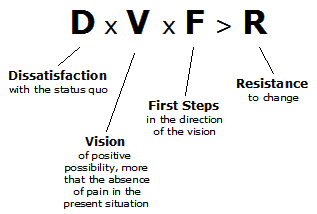Stepping up the game: How to achieve change in a sports club?

Constantly developing your sports club is a huge part of what club administrators do. If you don’t keep up with the times, you risk with stagnation and eventually losing out to your competition or to other sports. You risk becoming irrelevant.
So what can you do if you see that a change is necessary? How to take your club up to the next level on a technical, philosophical or organizational path? This can be a considerable task as people can become accustomed to their own ways. To help you with that, we have adjusted the 8-step process proposed by Harvard Business School professor Dr. John Kotter to the environment of the sports clubs.
1. Create a sense of urgency
This is the “why” of changing the organization – why do we need to change? Sports clubs can be naturally a rather conservative environment because of their (largely) non-profitable nature and focus on the mission rather than business goals. This core characteristic of a sports club is its greatest strength, but it can be also its greatest weakness. As the loyalty of its customers (athletes, fans, etc.) is naturally higher than for typical businesses, complacency within the club can set in and damage the long-term interests of the club.
That’s why it is so important for sports managers to first understand the need for change and then sharing this with the personnel that is affected by the change. For sports clubs, the personnel is usually the coaches. Managers need to be extremely clear and active when it comes to explaining the need for change to coaches.
The urgency for change can come from outside…
- the competition pushes you to act
- the legal or political environment (requirements for coaching qualifications etc.)
- the economic reality (the need to cut costs or the need to expand)
…or from the inside:
- the need to use the clubs maximum potential
- reorganizing the management systems for better effect
- volatility of athletes or coaches
- lack of fans or supporters
…and the list can go on forever. Wherever the impulse for change comes from, a common sense of urgency within the club that we actually DO need to change is essential for the change to actually take place.
2. Build a guiding coalition
When you have convinced the majority of your people that change is necessary, you need to start a team to lead this effort to change your sports club. Take a look at the main influencers and stakeholders in your club. Maybe you have a very vocal and trusted sports parent who can help you present the ideas to others? Maybe there’s a coach that others look up to when developing new coaching methods? Get these people on your side, you cannot lead the change on your own.
Look at all of the stakeholders affected by the change. Let’s take an example. You have identified the need to cut costs and start using shared car transport instead of buses to go to competitions. There are obvious people affected by it – the coaches and parents might have additional organizational tasks and the club management may have increased financial management tasks. However, if there is a definite sense of urgency to cut costs, you need leaders from all stakeholders to ensure that the change will go as smoothly as possible.

3. Form a strategic vision and initiatives
A clear picture of the future is important in here. People understand the need for change and you have your team to help you, but what exactly are they striving for? Do they believe in the same goals as you do?

Pictured above is a great equation to visualize what is needed for change. Dissatisfaction with the status quo is the foundation of change and the vision is it’s walls. Adding the first steps we get the roof that completes the house. Only then we can conquer the natural resistance to change.
For example, you want to introduce a new coaching philosophy for the whole club that focuses on the Long-Term Athlete Development (LTAD). There will be some doubters within the coaches or parents at first. Some parents might want to push their kids to be more competitive, some coaches may want to focus more on their own sport which – depending on the age group of the kids – can be detrimental to the athletes.
You and your team have to be prepared for that and keep on explaining the values that drive the vision. You need to have a strategy to reach your vision and the first steps to carry it out. Resistance to change can be hard to break. Getting everyone on board with your vision for the future takes time, but it is essential to ensure that change is successful and no bridges are burnt because of that.
4. Communicate the vision
Kotter International actually suggests “enlisting a volunteer army” as the fourth step, but I feel like the career-building website Mind Tools has a better step in here instead.
The communication of the new vision should not stop but instead should be a part of your everyday communication. To get larger masses of stakeholders behind your vision, put it on your website and share it on your social media and other communication channels. You can even have the core part of your new vision as your slogan or motto to communicate it on a daily basis.
Of course, communication is always a two-way process. Address the issues and problems that may arise quickly and don’t let them linger. Don’t let your coaches or parents be alone in figuring out the whys and whats of the vision, but be active in getting them on the same page. And most importantly, live by the values that your vision represents – it’s easier to believe a honest person than a hypocrite.
“You must be the change you wish to see in the world.” – Mahatma Gandhi
5. Enable action by removing barriers
Now that you’ve actually started implementing your vision, there will be some stumbling blocks on the way. Whether they are people or places or whatever, you have to identify the obstacles that are halting the change.
Let’s consider the change in coaching philosophy again. Now it’s easy to see people being barriers, but more often than not, they can just be a symptom of another barrier. Let’s imagine that there is a group of parents that are not yet on board with the new philosophy. However, these more skeptical parents may just be in need of more information and knowledge to track their kids progress. So what at first might have seen as a human barrier might actually be a communication barrier.
You might consider, for example, setting up monthly meetings with the parents to explain how the new philosophy works to create trust within the club. Inclusiveness in the decision-making process or at least accountability shown by the sports club are good ways to ensure that the obstacles are lessened with whatever change you’re making.
6. Generate short-term wins
Short-term wins are a certain way to keep people on board with your change. To do that, you have to evaluate and track your progress, perhaps putting down some milestones to keep your focus.
Let’s say you have implemented a new system at your sports club where your athletes have to keep an eye on their nutrition. It’s relatively easy to get people on board with your vision – for most people it is obvious that better nutrition brings better health. However, the longer term goal may be hard to implement when the daily routine kicks in.
Of course, the club administration might not be the most qualified people to evaluate the benefits of good nutrition, but work with coaches or other qualified people to work out a general plan on how to evaluate your successes. Short-term wins are essential to keep people motivated for your longer term vision.

7. Sustain acceleration
Your new policies have gathered some momentum and you can see the first wins, but don’t let complacency set in! Resting on your laurels will drag you back to the point where you started from and you don’t want all of this hard work to be in vain.
Always look at the next step ahead. You can be proud with how the coaches are putting the change into practice but maybe they can take it a step further and receive higher qualifications, new coaching badges, additional training? Maybe there are some parents who have become really the spokespersons for your cause and are willing to do even more for the club?
There’s an old saying that a rolling stone gathers no moss. Better keep that stone rolling then!
8. Institute change
Institutionalizing is a horrible word and an apology is due every time it is used (sorry!), but it describes the last important step for the change to persist.
You have yourself and your team of evangelists to support your new vision and the organization has accepted it and is moving in the right direction. The final step of introducing change is to make it a core part of your sports club. For example, what happens when you have to move and change jobs? Will the change revert itself because its preacher is gone?
Some ways to institutionalize (sorry!) the change can be procedural like new codes of conduct, new documents, philosophies, statues or charters. It’s like making a Bible for your sports club. Something to look into when you have doubts.
Other ways are less measurable like ensuring the change becomes a part of your club culture like a new mentality to live by. For example, a responsible financial management is institutionalized when it becomes a natural part of even the smallest transactions within your sports club – a part of what you are.
As you can see, changing your club for the better is no easy task. But to keep your sports club alive, sustainable and developing, keeping up with the times is a task which should be a part of your mission.
“Change is the law of life. And those who look only to the past or present are certain to miss the future.” – John F. Kennedy
